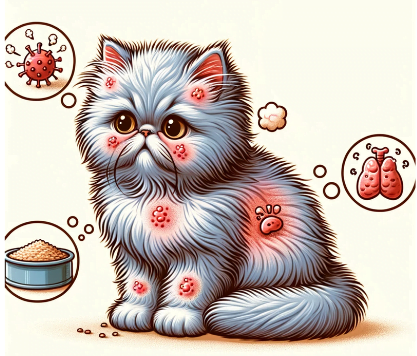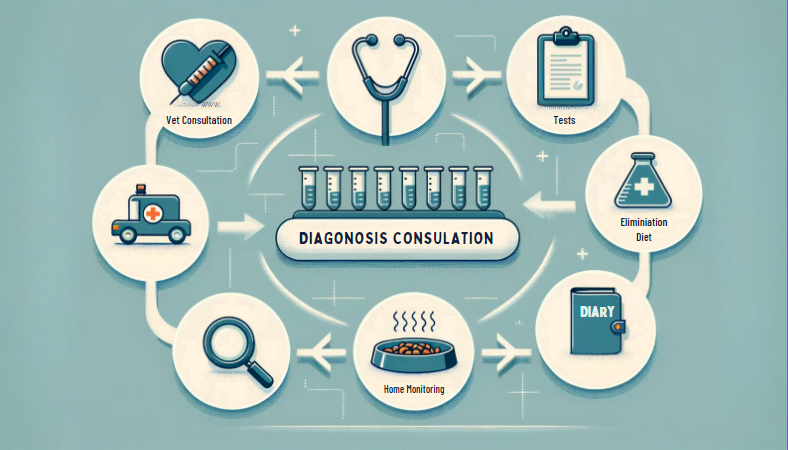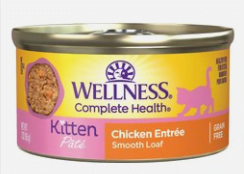This post contains affiliate links and I will be compensated if you make a purchase after clicking on my links
Introduction
The journey of caring for Persian Kittens has its set of challenges, and food allergies tops the list. Arming ourselves with knowledge about food allergies in Persian kittens is crucial for leveling up our caretaker game.
Food allergies in cats aren’t a modern-day glitch but a well-documented issue that can have varying levels of impact. They manifest when the immune system gives a ‘thumbs down’ to certain proteins or other components in their food, leading to a range of symptoms that can disrupt the daily cuddle sessions and laser pointer chases.
Understanding the intricacies of food allergies in Persian kittens not only forms a platform for providing optimal care but also opens a vista of engaging exploration for tech-savvy cat lovers. With the right mix of information and a sprinkle of playful curiosity, we can turn the tables on food allergies, ensuring our Persian pals continue to reign over their plush cushions, allergy-free.
As we delve deeper into the common allergens, symptoms, and modern methods to diagnose and combat food allergies, we’ll also whisk the enigma of food allergies in Persian kittens, ensuring they purr in content, nestled amidst a haven of health and happiness.
For a detailed guide on the dietary needs of Persian kittens, you can refer to The Science Behind Persian Kitten Diet
Common Allergens in Persian Kittens

Cats and humans share a common enemy when it comes to enjoying a hearty meal – allergens. In Persian kittens, the usual suspects behind the allergic reactions mostly revolve around certain foods. Let’s decode these common culprits:
- Proteins: Beef, chicken, or fish can sometimes trigger a ‘no entry’ sign from the kitten’s immune system. While proteins are essential for their growth and energy, not all proteins are greeted with purrs and cuddles.
- Dairy Products: Despite the popular imagery of cats enjoying a bowl of milk, many felines, including Persian kittens, may find dairy products hard to stomach. Lactose can be an unwelcome guest, leading to digestive dilemmas.
- Grains: Wheat and corn are often used as fillers in commercial cat foods, but they can also fill your Persian kitten with discomfort if they have a grain allergy.
- Additives and Preservatives: The modern-day cat food aisle is a carnival of colors and flavors, thanks to the array of additives and preservatives. However, these chemical guests can sometimes overstay their welcome, triggering allergies.
- Other Allergens: While the aforementioned allergens are the usual suspects, Persian kittens may have their unique set of dietary nemeses. It’s essential to keep a keen eye on how they react to different foods, especially if it’s a new brand or type.
The next leg of our journey will lead us through the signs that scream ‘food allergy’. For a well-rounded understanding and a list of recommended cat foods for Persian kittens, refer to our comprehensive page on cat food for Persian Kittens.
Symptoms of Food Allergies in Persian Kittens

Spotting the signs of food allergies in Persian kittens can be akin to decoding a complex software bug, but with a bit of feline finesse, we can get to the root of the issue. Here’s a rundown of the common symptoms that may indicate your Persian kitten is facing food allergy foes:
- Gastrointestinal symptoms: Food allergies can trigger unpleasant gastrointestinal responses in Persian kittens. This includes the not-so-pleasant vomiting and diarrhea, which are clear indicators that something’s amiss in the food department.
- Dermatological symptoms: If your Persian kitten is exhibiting a sudden interest in itching or has inflamed skin, it’s a red flag. These skin reactions signal that an allergen has breached the comfort zone.
- Respiratory symptoms: Coughing and wheezing are the distress signals sent out by your kitten’s respiratory system, indicating that an allergen is causing internal turbulence.
- Behavioral changes: Increased scratching or restlessness in your Persian kitten or any other behavioral changes are often a cat’s way of communicating discomfort or distress.
Diagnosis of Persian Kitten Allergens

Diagnosing food allergies in Persian kittens is a blend of professional insight and personal vigilance. Kicking things off with a veterinary consultation is a wise move. Early visits to the vet can shine a light on the issue before it escalates.
The vet may suggest a range of tests to unravel the mystery behind the allergic reactions. Among these, an elimination diet is a common first step, which is like playing a game of culinary detective to identify the offending allergens. Blood tests and skin tests are also part of the diagnostic toolkit, helping to unveil the hidden culprits behind the allergic reactions.
Now, switching gears to home monitoring, this is where your cat-loving instincts and observation skills come into play. Keeping a food diary is a simple yet effective way to track what’s on the menu and how your Persian kitten reacts to it. It’s about connecting the dots between the dining experiences and the subsequent encore of symptoms. Also, keeping a keen eye on any changes in behavior, skin condition, or digestive upsets and jotting them down can provide valuable insights.
Treatment and Management of Persian Kitten Allergens
Navigating the terrain of food allergies in Persian kittens requires a combination of dietary modifications, medical intervention, and consistent follow-ups. Let’s whisk through the array of options available to ensure your feline companion sails smoothly through the choppy waters of food allergies.
A dietary modification is often the first line of defense against food allergies. Transitioning to a hypoallergenic diet can be a game-changer. This diet is crafted to minimize the chances of allergic reactions, providing a safe eating zone for your Persian kitten.
Hypoallergenic sidesteps the usual suspects like corn, wheat, or white rice—common culprits behind intestinal troubles in cats with sensitive stomachs. With a low fiber encore and an absence of grain ingredients, it’s tailored to be gentle on your cat’s digestive system, making mealtime a harmonious experience. A good option is the Wellness Complete Health Grain-Free Kitten Formula.

When it comes to choosing between home-cooked meals and commercially prepared hypoallergenic diets, it’s a personal choice. Home-cooked meals allow for control over ingredients, while commercial diets come with the convenience factor and are formulated to meet all the nutritional needs of your kitten.
On the medical front, antihistamines and corticosteroids are often prescribed to manage and alleviate allergy symptoms. These medications act like little knights, battling the allergic reactions and providing relief from the discomfort they cause. Antihistamines are particularly effective in blocking the histamine receptors, thereby reducing allergic reactions. Corticosteroids, on the other hand, play a crucial role in reducing inflammation and itching, thus bringing a sigh of relief to your furry companion.
Immunotherapy is another alley that can be explored for managing allergies. By exposing the kitten to small amounts of the allergen, immunotherapy aims to desensitize the immune system over time, ultimately leading to a reduction or elimination of allergic reactions. This is a tailor-made solution, crafted based on the specific allergens affecting your kitten. It’s a journey toward building a more tolerant immune system and ensuring a happier, less itchy existence for your Persian kitten.
Regular check-ups and follow-ups with the vet are the cornerstone of effective allergy management. This ensures that the treatment plan is on the right track and adjustments can be made promptly if necessary.
Conclusion
Addressing food allergies is not merely a nod to responsible pet ownership, but a pledge to ensure the fluffy companions continue to thrive in our care.
Responsible pet ownership goes hand in hand with timely veterinary care. It’s about being proactive, attentive, and ever-ready to take the necessary steps that promise a healthier life for our Persian pals. The camaraderie between a pet and its owner is a cherished bond, and ensuring the well-being of our feline friends is a testament to this unique relationship.
The quest for awareness and education around food allergies in Persian kittens doesn’t end here. It’s a continuous journey, and there’s a vast terrain of knowledge waiting to be explored. The more we delve, the better equipped we become in ensuring our Persian kittens lead a life full of purrs and playful leaps.

Meet Sean, a fintech whiz with a penchant for pet purrs and blockchain buzz. After a decade of fintech feats, Sean’s tech talents leaped from ledger lines to litter lines, driven by a passion for pets and a vision for a more connected pet care community. With three critter companions as co-pilots, Sean launched this blog to share a treasury of pet-friendly tech tips and tales.


